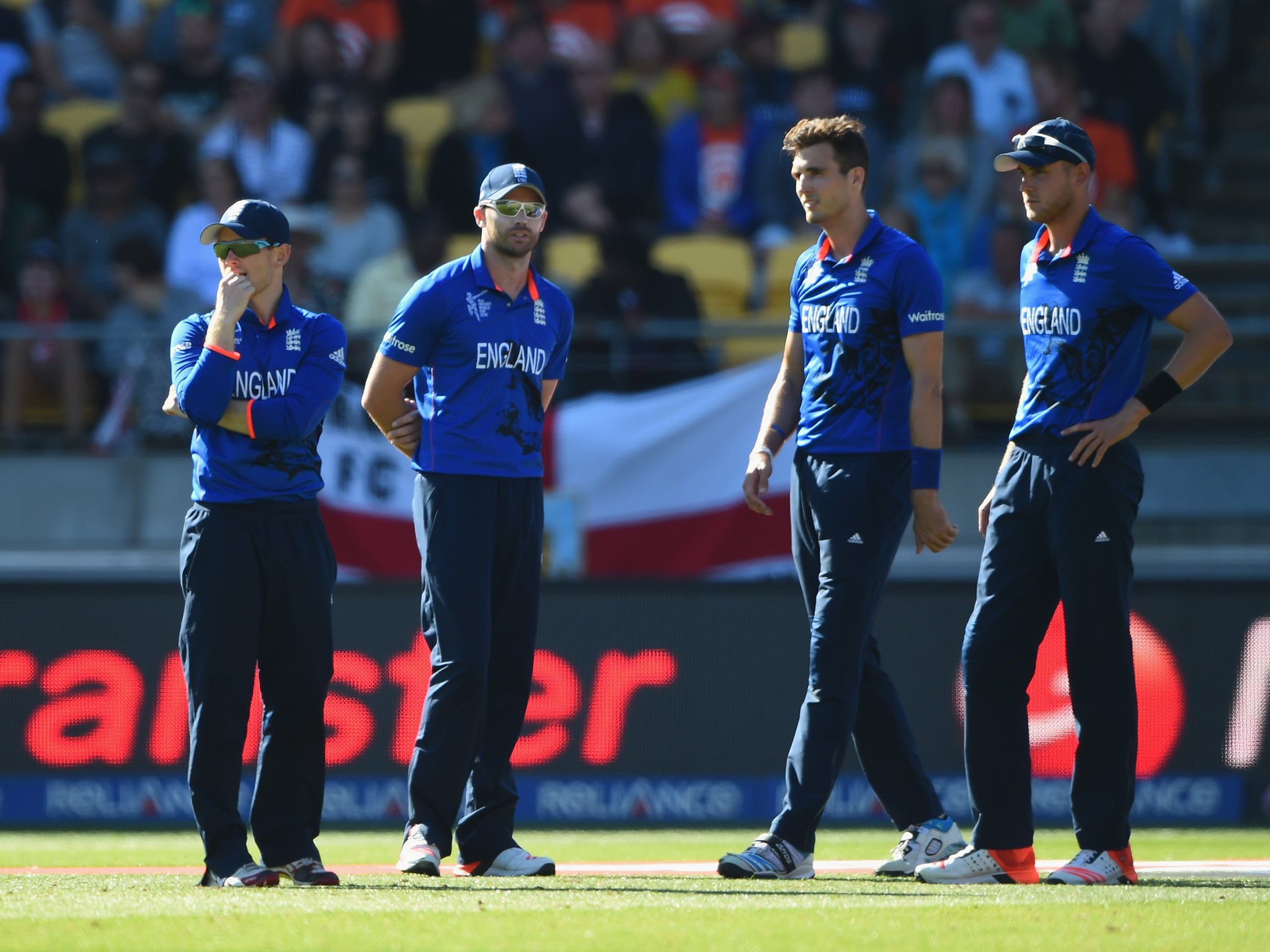England vs New Zealand: Tim Southee shows Eoin Morgan’s mob are unfit for purpose
New Zealand win by eight wickets after England were bowled out for 123

England planned meticulously for this World Cup. They rearranged Ashes series, they ditched Test cricket for eight months, they concentrated solely on the matter of one-day cricket. They had 16 matches and days and days of practice in between to plot and plan and scheme. This time, after five woebegone tournaments in succession, they would be ready.
Two matches into the 2015 version and they have been dismantled twice. England might as well have spent the time since August trying to work out how to negotiate heavy traffic in Dhaka or assessing the quality of their stamp collections. It could not have wasted more time. They have been anything but ready. The defeat by eight wickets to New Zealand yesterday was probably more of a humiliation than the loss by 111 runs to Australia on opening day.
Apprehension, the sense of being overwhelmed by the occasion, played a significant part in Melbourne last weekend. In Wellington yesterday, England were swept aside by a side more confident in what they were trying to do, much more aware of what being a modern one-day international entails.

True, they were confronted by an outstanding exhibition of late outswing bowling by Tim Southee but they were ill prepared to repel it. Southee and the other Kiwis seized the moment; England ran away from it.
It is said – because they keep saying it – that England’s players are better than they often show, that their skill levels are high. But this is what happened yesterday: the tie lasted a total of 45.4 overs; England were bowled out for 123 in 33.2 of them then New Zealand reached their target in the other 12.2.
When the draw was made for this competition, England were one of the top seeds, based on performances at the time. But as the two years since passed it became clear their opening matches against the host nations, Australia and New Zealand, would present formidable obstacles.
Deep down England knew that defeat in both was eminently possible but never, no matter how far into the depths of their souls they searched, would they or anyone else have thought there could be two such old-fashioned thrashings. If it says little for the players’ understanding of how to play in big-time contests, it perhaps says somewhat less for the retinue of coaches.

In its way, the cricket World Cup, like the Olympic Games or the football World Cup, is all about reaching a peak every four years. That is why England juggled with their programme, to give themselves the best chance. When things started to go badly wrong, they sacked their captain, Alastair Cook, six weeks before the tournament began and replaced him with Eoin Morgan. It is not exactly looking like a masterstroke.
Morgan is badly out of form, and after events yesterday he was in something of a daze, perfectly accepting of what had just happened but unsure how it had and what might be done about it.
England’s next match is against Scotland in Christchurch tomorrow night and it is one they should cruise. But victory will mean nothing in the bigger picture. Somehow, England have to assemble a display befitting the competition.
Their first and, as it turned out, catastrophic error yesterday was to bat on winning the toss. They like chasing targets but after their experience against Australia last Saturday, when 343 proved well beyond them, they were rather more reluctant. From the outset, Southee and his new-ball partner, Trent Boult, swung the ball. Unusual, perhaps, in one-day cricket these days but nothing too untoward for English batsmen brought up to rebuff the swinging ball.
Southee was exemplary. He removed Ian Bell with a beauty and then tricked Moeen Ali with a bouncer- yorker combination. There was something of a recovery, a determination by England not to roll over and have their tummies tickled. Then they rolled over and had their tummies tickled.
Morgan, anxious to attack, desperate to stamp his imprint on proceedings, had scratched around for 40 balls, half a lifetime longer than he has lately occupied the crease. He essayed a straight drive, it was short of the ropes and Adam Milne clung on to a superb running, diving catch. Half a chance, Morgan mused later, but actually meat and drink to today’s athletic fielders.
Southee, off after five overs, was instantly summoned back and just as quickly disrupted the rest of England’s innings. Of his seven victims – the best return by a New Zealander in an ODI – four were bowled, all with late full swing. Those who say it is a batsman’s game – which it is – might fail to appreciate that the modern batsman is not necessarily equipped to deal with bowling of this high calibre. Mostly, England could not lay a bat on it – and when they did it was slightly embarrassing.
What happened after they were dismissed was astonishing. Brendon McCullum, one of the great sluggers of the modern era, slugged to his heart’s content: 77 came from 25 balls, which included seven sixes, four of them in successive deliveries from Steve Finn.
This was a great New Zealand performance by a team who were indeed prepared for the World Cup. In the World Twenty20 last year, England were defeated by Netherlands in a match which had nothing riding on it. This felt worse. All the planning is hot air.
The players are not fit to compete against the better sides and results patently show it. One-day cricket has passed them by. They insist they are now playing a different brand of it but they can hardly emerge from the starting blocks to show it.
The quarter-finals of the 2015 World Cup still loom, so generous is the price of failure given the composition of the tournament. Then they would be only two matches away from the final. But that is not going to happen.
The first task before any of that is to beat Scotland. The Scots have nothing to lose; the English can lose anything.
--
MATCH IN NUMBERS
18 - Balls it took Brendon McCullum to hit his fifty – the fastest in the World Cup
71 - Balls it took for England to reach 50 runs
25 - McCullum finished on 77 from a total of 25 balls
7 - Number of sixes McCullum hit, as well as eight fours
7 - The Duckworth/Lewis par score when New Zealand were 96-0 in the sixth over
12.2 - Overs it took for New Zealand to win – the joint-quickest run chase against England
6.4 - Overs it took for NZ to reach 100 – the fastest in World Cup history
24.3 - Overs it took for England to reach 100
123 - England’s total – their third lowest at a World Cup
7-33 - Tim Southee’s figures – NZ’s best ever ODI bowling
2 - Number of bowlers who have returned better figures than Southee in a Wsorld Cup – Glenn McGrath (7 for 15) and Andy Bichel (7 for 20)
4.25 - Runs per ball – Steven Finn’s economy rate
226 - Balls remaining in New Zealand’s innings when they achieved their target, equalling England’s worst result
308 - McCullum’s strike rate during his 25-ball 77, the second-highest strike rate for a 50-plus innings in ODIs
Join our commenting forum
Join thought-provoking conversations, follow other Independent readers and see their replies
Comments